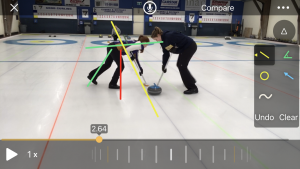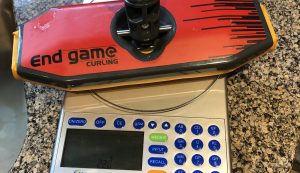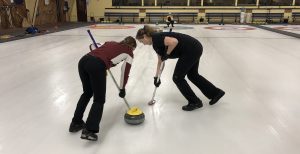Blog

Visualization of stone rotations for athlete feedback
This article is joint work with John Newhook of Dalhousie University in Halifax. It is well known that the number of rotations given to a stone, particularly at guard or draw weight, will impact both the duration of the shot and the stone’s trajectory as it travels down the ice. Upon release, a stone will have its maximum angular, or rotational, velocity (think number of rotations per second). Just as the speed of the stone slows with time, from this point until it stops, so does the stone’s rotational velocity. A “soft”, or gentle, application of angular acceleration (torque) to the handle upon release, with a relatively few number of rotations, tends to cause the stone to curl more, and sooner. Often such a release will cause the stone to “dig in” and fall short of the intended target. In extreme cases – a “straight” or “lazy” handle – the stone can actually stop rotating completely before it comes to

Moving to OnForm from Hudl Technique
I’ve been a long-time (since 2014) user of Hudl Technique (originally a software product called UberSense) for doing video analysis. With the quality camera systems now available on various Apple devices (and on Android devices as well) there is little need to use a separate camera system for on-ice or off-ice video analysis, and moreover using one’s personal device is decidedly more convenient. Those of you who are Hudl Technique users should have received an in-app notification that Hudl Technique is being discontinued and, later this year, the back-end video storage for Hudl Technique will vanish. However, the good news is that Hudl Technique was acquired by partners Gear Fisher and Krishna Ramachandran, who was the original developer of the UberSense software, and their new product, called OnForm, is designed to offer better video analysis than Hudl Technique and in addition permit royalty-free sharing of video, images, files, and annotations to athletes on their own devices with integrated messaging. With

Brush head mass – a short survey
During my talk at the online Adapting/Thriving 2021 Conference presented by the Ontario Curling Council, and other provincial sport organizations, I made several statements regarding potential parameters to the selection of a brush, among them being the size of the brush pad and its contact area with the ice. Even though WCF-approved brush heads and pads all utilize the same Oxford 55 420D yellow nylon fabric, and are tested by the National Research Council for compliance with World Curling Federation specifications, there are differences amongst the available products. Some brush pads have an integrated design, comprising the base, foam, and fabric as a single unit, whereas other brush pad designs use separate components so that the Oxford 55 fabric can be replaced independently of the foam or base. Perhaps the most interesting brush to do this is the End Game brush from Madison, Wisconsin, where the replacement fabric comes simply in die-cut sheets of Oxford 55 nylon. With the End

Curling stones: taken for granite
Derek Leung is a Canadian graduate student at the University of Edinburgh, Scotland. His research program in Geology is the study of curling stones; specifically the characteristics of a stone’s striking bands. He has sampled a large number of stones of different types, both from Ailsa Craig, Scotland and Trefor, Wales, and is analyzing the wear of each type of stone. His research program is highlighted in a recent issue of the magazine of the Edinburgh Geological Society: The background for his current work at Edinburgh is from his B.Sc. thesis in Geology from Laurentian University. In his thesis, Derek studied the four common types of granite found in curling stones (Ailsa Craig blue hone, Ailsa Craig common green, Trefor red, and Trefor blue) and looked at their geological makeup, specifically the amount of quartz present in the stone. Here is an excerpt from the introduction to his thesis (abbreviations have been removed to improve clarity): The World Curling Federation

How far can one carry a stone via brushing?
After questions regarding directional brushing, perhaps the second-most often asked question I receive is the question of how much distance brushing can add to the trajectory of a stone. While it is tempting to consider a cut-and-dried response, the issues involved in brushing are both complex and incompletely understood, since we are still researching the physics behind what makes a curling stone “curl” in the first place. Experienced players know that under some conditions it seems that brushing can carry a stone a significant additional distance, yet at other times it doesn’t seem to matter how hard one brushes, the impact upon the stone’s travel is minimal. Answering the question of brushing impact involves an analysis of three significant variables: the characteristics of the ice surface, and the corresponding environment within the arena; the characteristics of the curling stones themselves, and how they were thrown; and the abilities and techniques of the player(s) involved in brushing. Let’s look at these

Summer training plans for front-end players
As I write this, I am a mere four weeks from returning to the ice at the Curling Canada NextGen camp, to be held at the K-W Granite Club here in Waterloo. The OJCT Tour will begin Labour Day weekend – just six weeks away. With the competitive U21 season in Ontario so compressed – 12 weeks between Labour Day and U-21 qualifiers – the summer months are THE time to improve one’s fitness, enhance flexibility, and permit injuries to heal. Between the demands of post-secondary school and the competitive season, there will be little time to improve one’s fitness during the fall semester. Rather, the best one can hope for is to maintain the elevated fitness levels achieved during the summer months through the competitive season. Every competitive player should have a summer training plan designed by a qualified personal trainer or kinesiologist. While a “generic” training plan is slightly less costly, ideally a customized plan designed for you